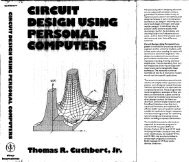Cuthbert, 2000 - IEEE Global History Network
Cuthbert, 2000 - IEEE Global History Network
Cuthbert, 2000 - IEEE Global History Network
You also want an ePaper? Increase the reach of your titles
YUMPU automatically turns print PDFs into web optimized ePapers that Google loves.
neighborhoods of uncertain impedance at each frequency also<br />
can be broadband matched efficiently.<br />
5. EXAMPLE<br />
There is a double-match example that cannot be solved by the<br />
classical insertion loss method [7]. The source and load models<br />
shown in Figure 8 are seldom known; however, their impedance<br />
data in the desired passband from 0.3 to 1.0 rad/s in 0.1 intervals<br />
are assumed given. The source resistance being zero at 1.29 rad/s<br />
is particularly difficult. The RFT method in [7] utilizes several<br />
arbitrary approximations, optimizations, and synthesis steps to<br />
yield a six-element equalizer with passband loss 0.85 to 1.42 dB.<br />
1.0<br />
0.75<br />
0.3 2.0 LOSSLESS<br />
E 4<br />
S EQUALIZER<br />
Figure 8. A difficult broadband matching problem.<br />
The GRABIM technique used the same data and a six- element<br />
equalizer topology consisting of a Pi of L’s at the source<br />
followed by a Pi of C’s at the load. (The source is capacitive and<br />
the load is inductive; Pi networks implicitly contain ideal<br />
transformers.) The grid search required 7026 network analyses<br />
performed in 2 seconds by a 200 MHz PC; the worst-case<br />
insertion loss was reduced to 2.6 dB. A few Lagrange multiplier<br />
loops reduced the loss to 1.24 dB while automatically removing<br />
one L and one C. See Figure 9(a); two other solutions started<br />
from other topologies also are shown in Figures 9(b) and 9(c).<br />
(a) Best case found:<br />
0.97 < S 21 dB < 1.24<br />
(b) Five branch bandpass:<br />
1.21 < S 21 dB < 1.63<br />
(c) Five branch highpass:<br />
0.88 < S 21 dB < 1.75<br />
0.56<br />
0.72<br />
0.85<br />
0.68<br />
(a)<br />
(b)<br />
4.34<br />
(c)<br />
7.84<br />
4.00<br />
2.26<br />
2.37<br />
2.34<br />
1.07<br />
2.45<br />
1.40<br />
Figure 9. Three full-rank broadband network solutions.<br />
1<br />
8.92<br />
6. SUMMARY<br />
The GRABIM RFT is a pure numerical optimization algorithm<br />
that is fast, simple, and reliable. It solves double-match problems<br />
as easily as single-match problems. GRABIM locates a likelyglobal<br />
optimal solution for a given topology and eliminates<br />
unnecessary branches during a two-stage process of optimizing<br />
equalizer elements. Mixed lumped and distributed elements are<br />
allowed, based on clearly defined behavior of reflection<br />
magnitude versus element variables. Inexpensive, documented<br />
software is available from the author.<br />
GRABIM features:<br />
• Measured single- or double-match source and load<br />
impedance data at sampled passband frequencies,<br />
• Noncritical choice of frequency samples,<br />
• Mixed lumped/distributed equalizer elements,<br />
• Bandpass or lowpass equalizers,<br />
• Arbitrary or stored candidate topologies of varying degree,<br />
• Automatic elimination of unnecessary elements,<br />
• No element initial values required,<br />
• Bounds or holds on element values,<br />
• Efficient broadband matching of impedance neighborhoods,<br />
• Likely-global optimal solutions, and<br />
• Proven, well-conditioned numerical techniques.<br />
7. REFERENCES<br />
[1] Carlin, H. J. and P. P. Civalleri (1998). Wideband Circuit<br />
Design. NY: CRC Press.<br />
[2] Fletcher, R. (1980-1981). Practical Methods of Optimization:<br />
Unconstrained Optimization, Vol. 1, and<br />
Constrained Optimization, Vol. 2. NY: John Wiley.<br />
[3] Dedieu, H., C. Dehollain, J. Neirynck, and G. Rhodes<br />
(1994). A new method for solving broadband matching<br />
problems. <strong>IEEE</strong> Trans. Circuits and Sys., V41, N9.<br />
Sept.:561-571.<br />
[4] Torczon, V. (1991). On the convergence of the multidirectional<br />
search algorithm. SIAM J. Opti., V1, N1.<br />
Feb.:123-145.<br />
[5] Powell, M. J. D. (1969). A method for nonlinear constraints<br />
in minimization problems, in Optimization, R. Fletcher, Ed.<br />
NY: Academic Press, pp. 283-297.<br />
[6] Orchard, H. J. (1985). Filter design by iterated analysis.<br />
<strong>IEEE</strong> Trans. Circuits & Sys., V32, N11. Nov.:1089-96.<br />
[7] Yarman, B. S. and A. Fettweis (1990). Computer-aided<br />
double matching via parametric representation of Brune<br />
functions. <strong>IEEE</strong> Trans. Circuits & Sys., V37, N2. Feb.:212-<br />
222.<br />
V-404

















